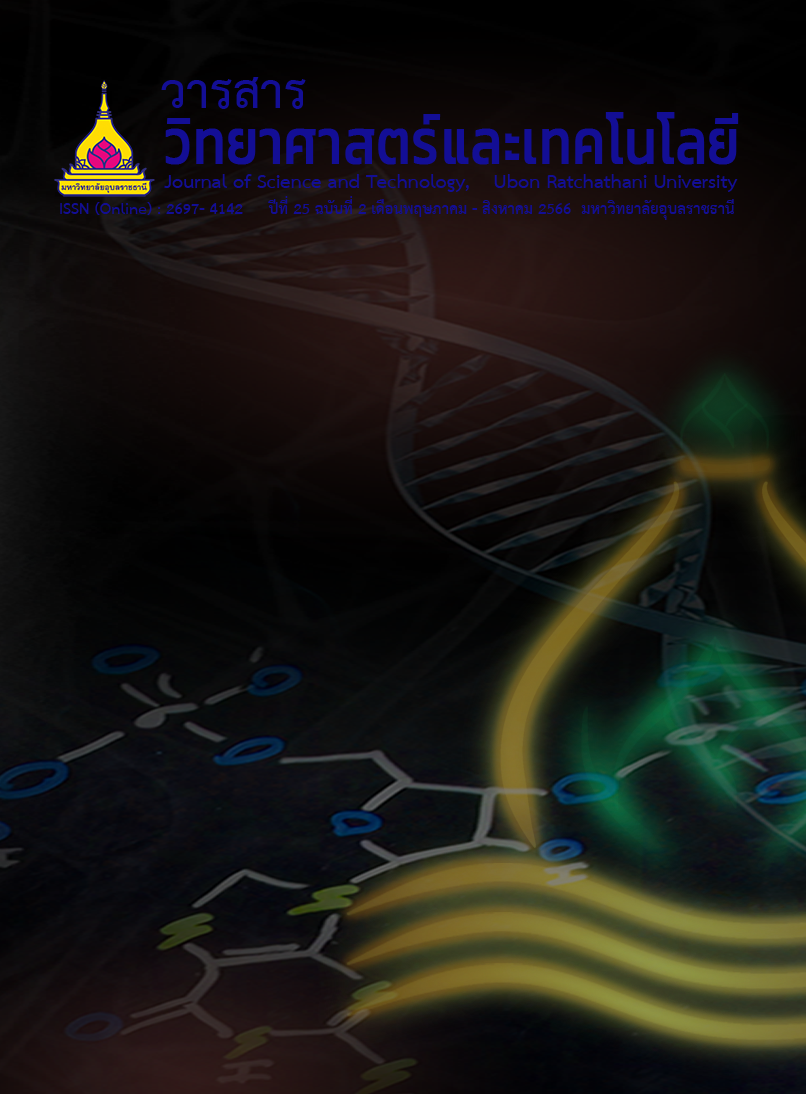อิทธิพลของคุณสมบัติทางเคมีของดินและชนิดของสารหนูต่อการดูดสะสมสารหนูของธูปฤาษีในสภาพดินน้ำขัง
Main Article Content
บทคัดย่อ
ธูปฤาษีเป็นพืชที่สามารถกำจัดสารหนูจากดินโดยการดูดซับจากดินมาสะสมในพืช งานวิจัยนี้มีวัตถุประสงค์เพื่อศึกษาอิทธิพลของคุณสมบัติทางเคมีของดิน และชนิดของสารหนูต่อการดูดสะสมสารหนูของธูปฤาษีในสภาพดินน้ำขัง โดยคุณสมบัติทางเคมีของดินที่ศึกษา ได้แก่ ความเป็นกรดด่าง ศักยภาพการเกิดออกซิเดชันรีดักชัน เหล็กที่สกัดได้ อะลูมิเนียมที่แลกเปลี่ยนได้ แมกนีเซียมที่แลกเปลี่ยนได้ แคลเซียมที่แลกเปลี่ยนได้ และฟอสฟอรัสที่เป็นประโยชน์ งานวิจัยนี้เป็นแบบแฟคทอเรียล 3 × 4 ประกอบด้วย 2 ปัจจัย ปัจจัยแรก คือ ชนิดของดิน ซึ่งได้แก่ ดินที่ไม่มีสารหนู (ชุดควบคุม) ดินที่มีอาร์เซไนต์ [As(III)] และดินที่มีอาร์เซเนต [As(V)] ส่วนปัจจัยที่ 2 คือ จำนวนวันที่เพาะปลูกธูปฤาษี ซึ่งได้แก่ 15, 30, 45 และ 60 วัน ตรวจสอบคุณสมบัติทางเคมีของดินทุกชุดก่อนการปลูกธูปฤาษี และตรวจสอบปริมาณสารหนูทั้งหมดที่ธูปฤาษีดูดสะสมหลังจากการปลูกธูปฤาษีเป็นเวลา 15, 30, 45 และ 60 วัน ผลการศึกษาแสดงให้เห็นว่าความเป็นกรดด่าง ศักยภาพการเกิดออกซิเดชันรีดักชัน ปริมาณของอะลูมิเนียมที่แลกเปลี่ยนได้ ปริมาณของแมกนีเซียมที่แลกเปลี่ยนได้ และปริมาณของฟอสฟอรัสที่เป็นประโยชน์ ไม่มีความแตกต่างกันอย่างมีนัยสำคัญในดินทุกชุด ส่วนเหล็กที่สกัดได้มีในดินที่มีอาร์เซไนต์ และดินที่มีอาร์เซเนตมากกว่าในดินชุดควบคุมอย่างมีนัยสำคัญ แคลเซียมที่แลกเปลี่ยนได้มีในดินที่มีอาร์เซเนต และดินชุดควบคุมมากกว่าในดินที่มีอาร์เซไนต์อย่างมีนัยสำคัญ นอกจากนี้จากการศึกษายังพบว่าธูปฤาษีดูดสะสมอาร์เซไนต์ได้ดีกว่าอาร์เซเนตในทุกช่วงเวลาที่ตรวจวัด การวิเคราะห์การถดถอยพหุคูณแสดงให้เห็นว่าปัจจัยที่สามารถใช้พยากรณ์ปริมาณสารหนูทั้งหมดที่ธูปฤาษีดูดสะสม ได้แก่ ศักยภาพการเกิดออกซิเดชันรีดักชัน ชนิดของสารหนู และแคลเซียมที่แลกเปลี่ยนได้ โดยสมการพยากรณ์ คือ TAA = 197.834 - 0.350 (Eh) + 25.150 (AS) - 0.218 (Ca) เมื่อ TAA คือ ปริมาณสารหนูทั้งหมดที่ธูปฤาษีดูดสะสม Eh คือ ศักยภาพการเกิดออกซิเดชันรีดักชัน AS คือ ชนิดของสารหนู และ Ca คือ แคลเซียมที่แลกเปลี่ยนได้
Article Details

อนุญาตภายใต้เงื่อนไข Creative Commons Attribution-NonCommercial-NoDerivatives 4.0 International License.
บทความที่ได้รับการตีพิมพ์เป็นลิขสิทธิ์ของ วารสารวิทยาศาสตร์และเทคโนโลยี มหาวิทยาลัยอุบลราชธานี
ข้อความที่ปรากฏในบทความแต่ละเรื่องในวารสารวิชาการเล่มนี้เป็นความคิดเห็นส่วนตัวของผู้เขียนแต่ละท่านไม่เกี่ยวข้องกับมหาวิทยาลัยอุบลราชธานี และคณาจารย์ท่านอื่นๆในมหาวิทยาลัยฯ แต่อย่างใด ความรับผิดชอบองค์ประกอบทั้งหมดของบทความแต่ละเรื่องเป็นของผู้เขียนแต่ละท่าน หากมีความผิดพลาดใดๆ ผู้เขียนแต่ละท่านจะรับผิดชอบบทความของตนเองแต่ผู้เดียว
เอกสารอ้างอิง
Masscheleyn, P.H., Delaune, R.D. and Patrick, W.H. 1991. Effect of redox potential and pH on arsenic speciation and solubility in a contaminated soil. Environmental Science & Technology. 25(8): 1414-1419.
Lee, K.S. and et al. 2015. The fate and factors determining arsenic mobility of arsenic in soil-A review. Korean Journal of Soil Science and Fertilizer. 48(2): 73-80.
Sun, W. and et al. 2009. Arsenite and ferrous iron oxidation linked to chemolithotrophic denitrification for the immobilization of arsenic in anoxic environments. Environmental Science & Technology. 43(17): 6585-6591.
Lin, T.F. and Wu, J.K. 2001. Adsorption of arsenite and arsenate within activated alumina grains: Equilibrium and kinetics. Water Research. 35(8): 2049-2057.
Bhattacharya, S. and et al. 2021. Arsenic uptake and bioaccumulation in plants: A review on remediation and socio-economic perspective in Southeast Asia. Environmental Nanotechnology, Monitoring & Management. 15: 100430.
Dixit, S. and Hering, J.G. 2003. Comparison of arsenic(V) and arsenic(III) sorption onto iron oxide minerals: Implications for arsenic mobility. Environmental Science & Technology. 37(18): 4182-4189.
Shaibur, M.R., Adjadeh, T.A., and Kawai, S. 2013. Effect of phosphorus on the concentrations of arsenic, iron and some other elements in barley grown hydroponically. Journal of Soil Science and Plant Nutrition. 13(1): 87-98.
Bednar, A.J. and et al. 2005. Effects of iron on arsenic speciation and redox chemistry in acid mine water. Journal of Geochemical Exploration. 85(2): 55-62.
Azam, M.S., Shafiquzzaman, M. and Nakajima, J. 2010. Effect of calcium and magnesium addition on arsenic leaching from paddy field soil by Bangladesh. Journal of Water and Environment Technology. 8(4): 329-338.
Smith, E., Naidu, R. and Alston, A.M. 2002. Chemistry of inorganic arsenic in soils II. Effect of phosphorus, sodium, and calcium on arsenic sorption. Journal of Environmental Quality. 31(2): 557-563.
Masue, Y., Loeppert, R.H. and Kramer, T.A. 2007. Arsenate and arsenite adsorption and desorption behavior on coprecipitated aluminum: iron hydroxides. Environmental Science & Technology. 41(3): 837-842.
Giles, D.E. and et al. 2011. Iron and aluminium based adsorption strategies for removing arsenic from water. Journal of Environmental Management. 92(12): 3011-3022.
Abbas, G. and et al. 2018. Arsenic uptake, toxicity, detoxification, and speciation in plants: physiological, biochemical, and molecular aspects. International Journal of Environmental Research and Public Health. 15(1): 59.
Nateewattana, J. and et al. 2018. Arsenic remediation in speciation of arsenite As(III) and arsenate As(V) in submerged soil by Typha angustifolia L. KKU Science Journal. 46(3): 506-516. (in Thai)
John, R., Estefan, G. and Rashid, A. 2001. Soil and Plant Analysis Laboratory Manual. 2nd edition. Beirut: International Center for Agricultural Research in the Dry Areas.
Stevens, J. 1992. Applied Multivariate Statistics for the Social Sciences. 2nd edition. Mahwah: Lawrance Erlbaum Associate, Inc.
Marcoulides, K.M. and Raykov, T. 2019. Evaluation of variance inflation factors in regression models using latent variable modeling methods. Educational and Psychological Measurement. 79(5): 874-882.
Gersztyn, L., Karczewska, A. and Galka, B. 2013. Influence of pH on the solubility of arsenic in heavily contaminated soils. Environmental Protection and Natural Resources. 3(5): 7-11.
Nateewattana, N. and et al. 2018. Arsenic phytoremediation of submerged soil using Canna glauca (L.). Journal of Science and Technology, Ubon Ratchathani University. 21(1): 90-100. (in Thai)
Aksorn, E. and Visoottiviseth, P. 2004. Selection of suitable emergent plants for removal of arsenic from arsenic contaminated water. ScienceAsia. 30: 105-113.
Phuekvilai, P., Sirichamorn, Y. and Yookongkaew, N. 2017. Arsenic accumulation of dominant herbaceous plants growing around gold mine areas. Thai Science and Technology Journal. 26(6): 953-967. (in Thai)
Niero, L. 2013. Assessment of As Contaminated Soil Stabilized with Iron Amendments by Laboratory and Field Experiments. M.Sc. Thesis, Universita’ Degli Studi Di Padova.
Magalhaes, M.C.F. 2002. Arsenic. An environmental problem limited by solubility. Pure and Applied Chemistry. 74(10): 1843-1850.
Soil Science Department, Kasetsart University. 2005. Introduction to Soil Science. 10th edition. Bangkok: Kasetsart University Press. (in Thai)
Ghosh, B. and et al. 2003. Removal of arsenic from water by coagulation treatment using iron and magnesium salt. Indian Journal of Chemical Technology. 10: 87-95.
Roman-Ross, G. and et al. 2006. Arsenite sorption and co-precipitation with calcite. Chemical Geology. 233: 328-336.
Bothe, J.V. and Brown, P.W. 1991. Arsenic immobilization by calcium arsenate formation. Environmental Science & Technology. 33(21): 3806-3811.
Strawn, D.G. 2018. Review of interactions between phosphorus and arsenic in soils from four case studies. Geochemical Transactions. 19: 10.
Johanna, L. 2017. Phosphorus in the Sediment of Agricultural Constructed Wetlands. Ph.D. Dissertation, University of Helsinki.


